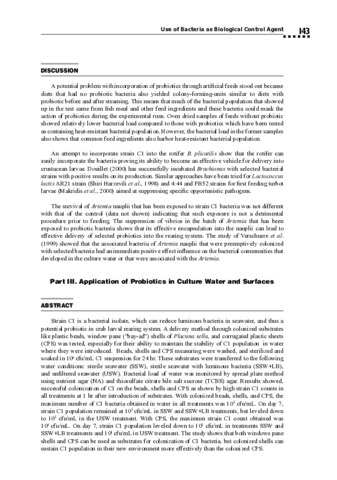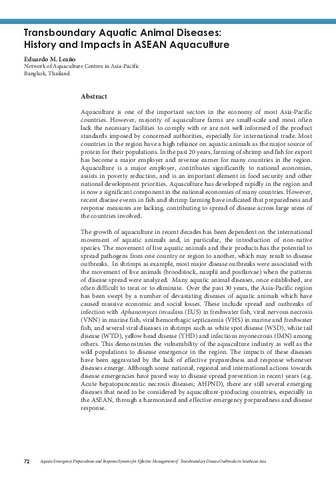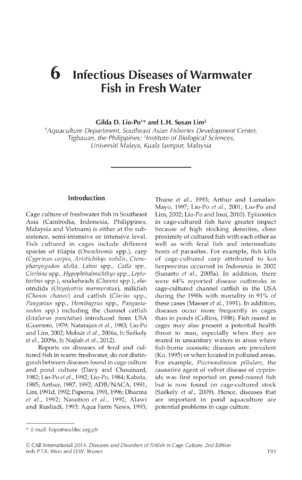Use of bacteria as biological control agent against microbial diseases in shrimp (Penaeus monodon) and crab (Scylla serrata) hatcheries: Part III. Application of probiotics in culture water and surfaces
| dc.contributor.author | Lavilla-Pitogo, Celia R. | |
| dc.contributor.author | de la Peña, Leobert D. | |
| dc.contributor.author | Catedral, Demy D. | |
| dc.contributor.editor | Nagasawa, Kazuya | |
| dc.date.accessioned | 2020-07-22T01:06:23Z | |
| dc.date.available | 2020-07-22T01:06:23Z | |
| dc.date.issued | 2005-03 | |
| dc.identifier.citation | Lavilla-Pitogo, C. R., de la Peña, L. D., & Catedral, D. D. (2005). Use of bacteria as biological control agent against microbial diseases in shrimp (Penaeus monodon) and crab (Scylla serrata) hatcheries: Part III. Application of probiotics in culture water and surfaces. In K. Nagasawa (Ed.), Recent Advances in Diagnosis and Prevention of Fish and Shrimp Diseases in Southeast Asia (pp. 143–152). Tigbauan, Iloilo, Philippines: Aquaculture Department, Southeast Asian Fisheries Development Center. | en |
| dc.identifier.isbn | 9718511732 | |
| dc.identifier.uri | http://hdl.handle.net/10862/5922 | |
| dc.description.abstract | Strain C1 is a bacterial isolate, which can reduce luminous bacteria in seawater, and thus a potential probiotic in crab larval rearing system. A delivery method through colonized substrates like plastic beads, window pane (“bay-ad”) shells of Placuna sella, and corrugated plastic sheets (CPS) was tested, especially for their ability to maintain the stability of C1 population in water where they were introduced. Beads, shells and CPS measuring were washed, and sterilized and soaked in 106 cfu/mL C1 suspension for 24 hr. These substrates were transferred to the following water conditions: sterile seawater (SSW), sterile seawater with luminous bacteria (SSW+LB), and unfiltered seawater (USW). Bacterial load of water was monitored by spread plate method using nutrient agar (NA) and thiosulfate citrate bile salt sucrose (TCBS) agar. Results showed, successful colonization of C1 on the beads, shells and CPS as shown by high strain C1 counts in all treatments at 1 hr after introduction of substrates. With colonized beads, shells, and CPS, the maximum number of C1 bacteria obtained in water in all treatments was 105 cfu/mL. On day 7, strain C1 population remained at 105 cfu/mL in SSW and SSW+LB treatments, but leveled down to 103 cfu/mL in the USW treatment. With CPS, the maximum strain C1 count obtained was 104 cfu/mL. On day 7, strain C1 population leveled down to 102 cfu/mL in treatments SSW and SSW+LB treatments and 101 cfu/mL in USW treatment. The study shows that both windows pane shells and CPS can be used as substrates for colonization of C1 bacteria, but colonized shells can sustain C1 population in their new environment more effectively than the colonized CPS. | en |
| dc.language.iso | en | en |
| dc.publisher | Aquaculture Department, Southeast Asian Fisheries Development Center | en |
| dc.subject | disease prevention | en |
| dc.title | Use of bacteria as biological control agent against microbial diseases in shrimp (Penaeus monodon) and crab (Scylla serrata) hatcheries: Part III. Application of probiotics in culture water and surfaces | en |
| dc.type | Book chapter | en |
| dc.citation.spage | 143 | en |
| dc.citation.epage | 152 | en |
| dc.citation.bookTitle | Recent Advances in Diagnosis and Prevention of Fish and Shrimp Diseases in Southeast Asia | en |
| dc.subject.asfa | probiotics | en |
| dc.subject.asfa | biofilms | en |
| dc.subject.asfa | antibiotics | en |
| dc.subject.asfa | animal diseases | en |
| dc.subject.asfa | biological control | en |
| dc.subject.asfa | crustacean culture | en |
| dc.subject.asfa | aquaculture | en |
| dc.subject.asfa | colonization | en |
| dc.subject.asfa | aquaculture systems | en |
| dc.subject.asfa | crab culture | en |
| dc.subject.scientificName | Placuna sella | en |
| dc.subject.scientificName | Vibrio harveyi | en |
このアイテムのファイル
このアイテムは次のコレクションに所属しています
-
Recent Advances in Diagnosis and Prevention of Fish and Shrimp Diseases in Southeast Asia [43]
Terminal Report of the Regional Fish Disease Project on “Development of Fish Disease Inspection Methodologies for Artificially-Bred Seeds” Funded by the Government of Japan Trust Fund from 2000 to 2004


 AQD Access only
AQD Access only


